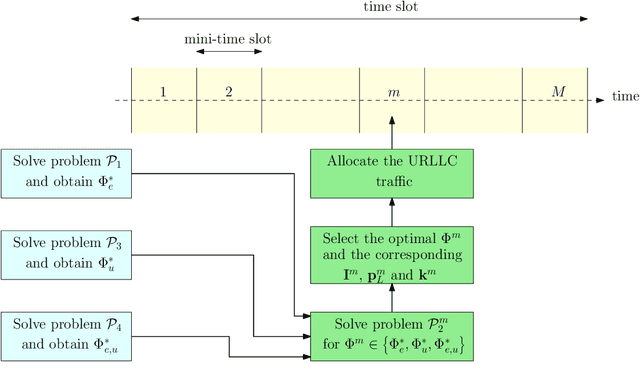Joint Resource Allocation and Phase Shift Optimization for RIS-Aided eMBB/URLLC Traffic Multiplexing
Paper and Code
Aug 05, 2021



This paper studies the coexistence of enhanced mobile broadband (eMBB) and ultra-reliable and low-latency communication (URLLC) services in a cellular network that is assisted by a reconfigurable intelligent surface (RIS). The system model consists of one base station (BS) and one RIS that is deployed to enhance the performance of both eMBB and URLLC in terms of the achievable data rate and reliability, respectively. We formulate two optimization problems, a time slot basis eMBB allocation problem and a mini-time slot basis URLLC allocation problem. The eMBB allocation problem aims at maximizing the eMBB sum rate by jointly optimizing the power allocation at the BS and the RIS phase-shift matrix while satisfying the eMBB rate constraint. On the other hand, the URLLC allocation problem is formulated as a multi-objective problem with the goal of maximizing the URLLC admitted packets and minimizing the eMBB rate loss. This is achieved by jointly optimizing the power and frequency allocations along with the RIS phase-shift matrix. In order to avoid the violation in the URLLC latency requirements, we propose a novel framework in which the RIS phase-shift matrix that enhances the URLLC reliability is proactively designed at the beginning of the time slot. For the sake of solving the URLLC allocation problem, two algorithms are proposed, namely, an optimization-based URLLC allocation algorithm and a heuristic algorithm. The simulation results show that the heuristic algorithm has a low time complexity, which makes it practical for real-time and efficient multiplexing between eMBB and URLLC traffic. In addition, using only 60 RIS elements, we observe that the proposed scheme achieves around 99.99\% URLLC packets admission rate compared to 95.6\% when there is no RIS, while also achieving up to 70\% enhancement on the eMBB sum rate.
 Add to Chrome
Add to Chrome Add to Firefox
Add to Firefox Add to Edge
Add to Edge